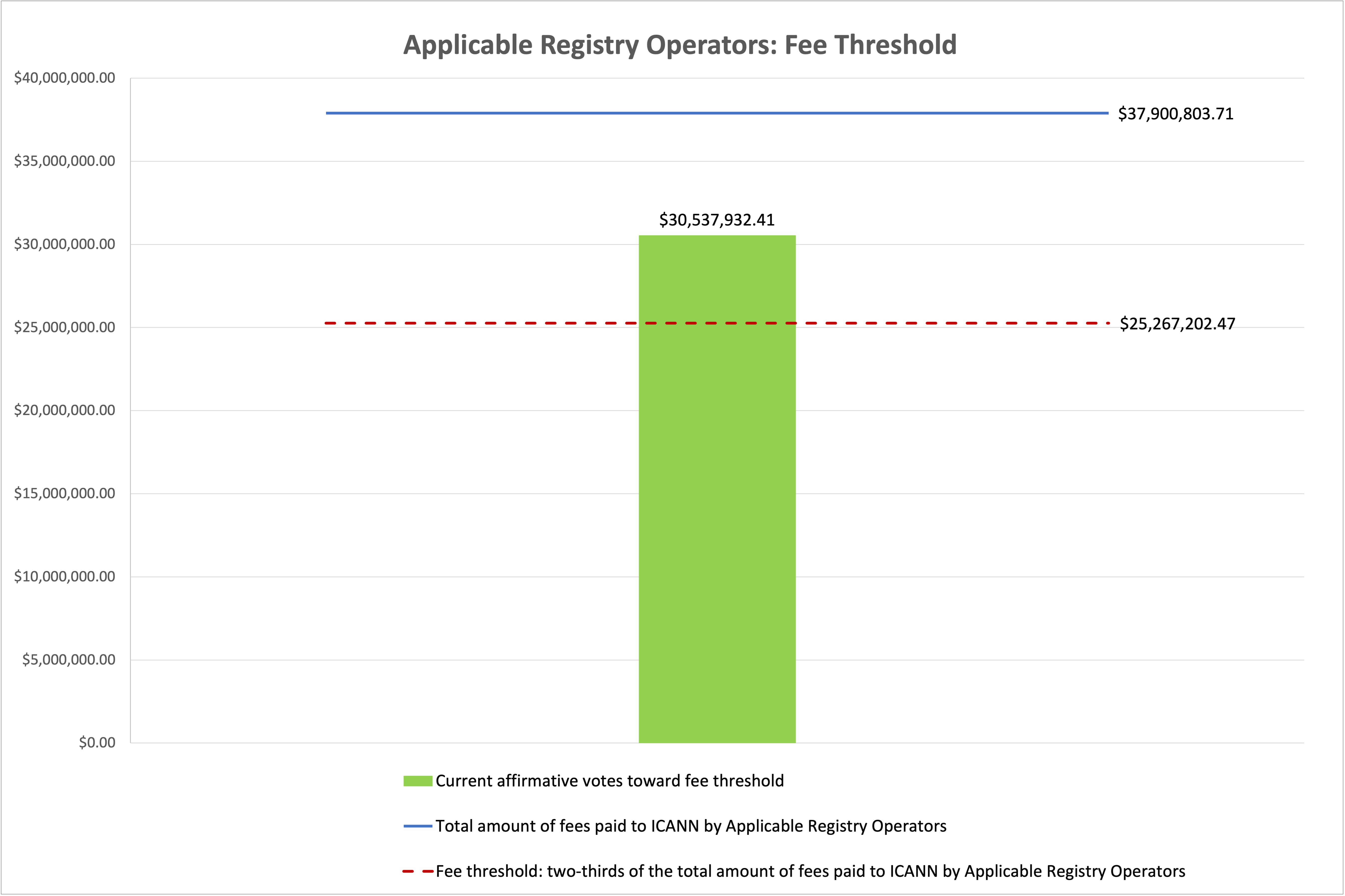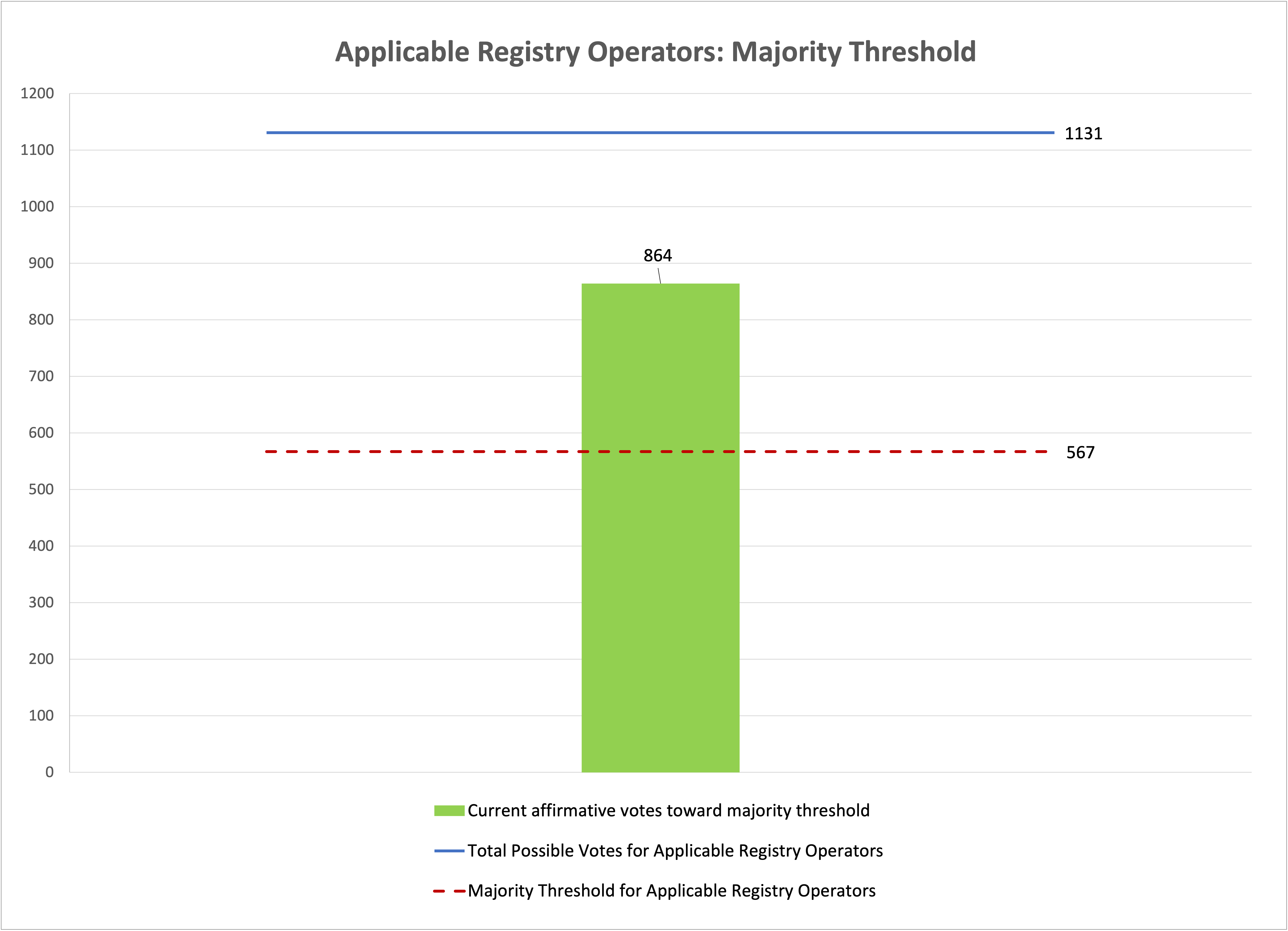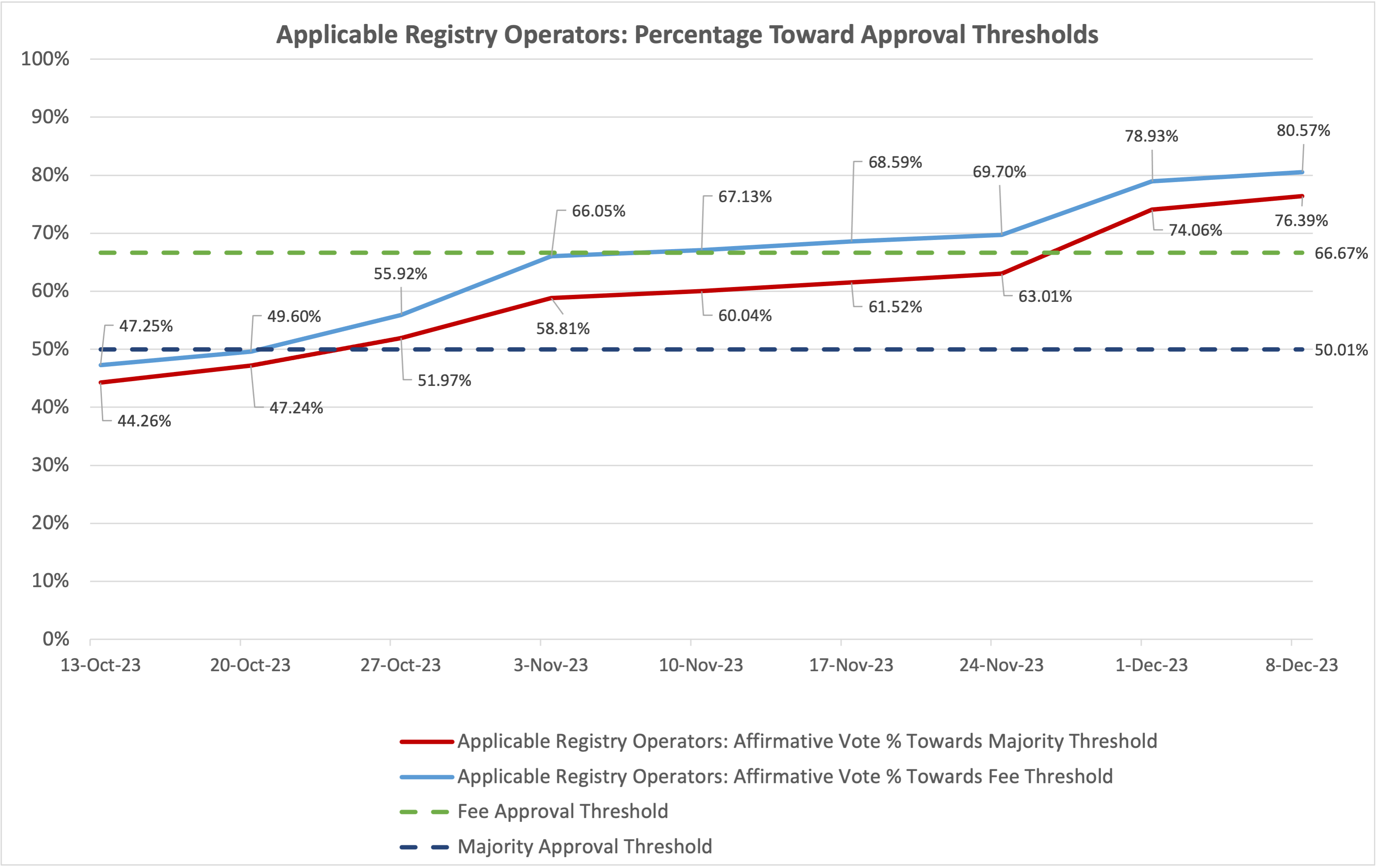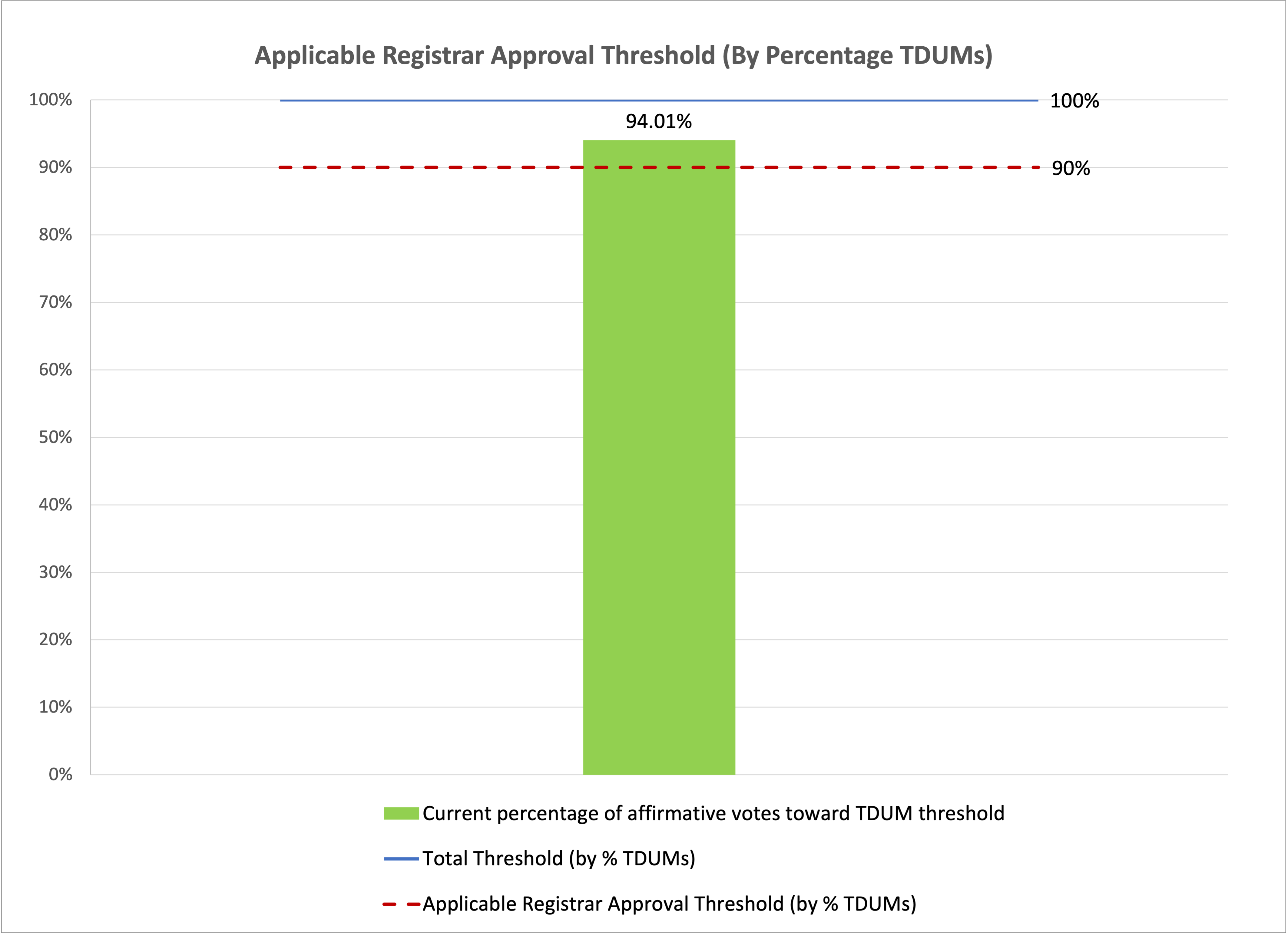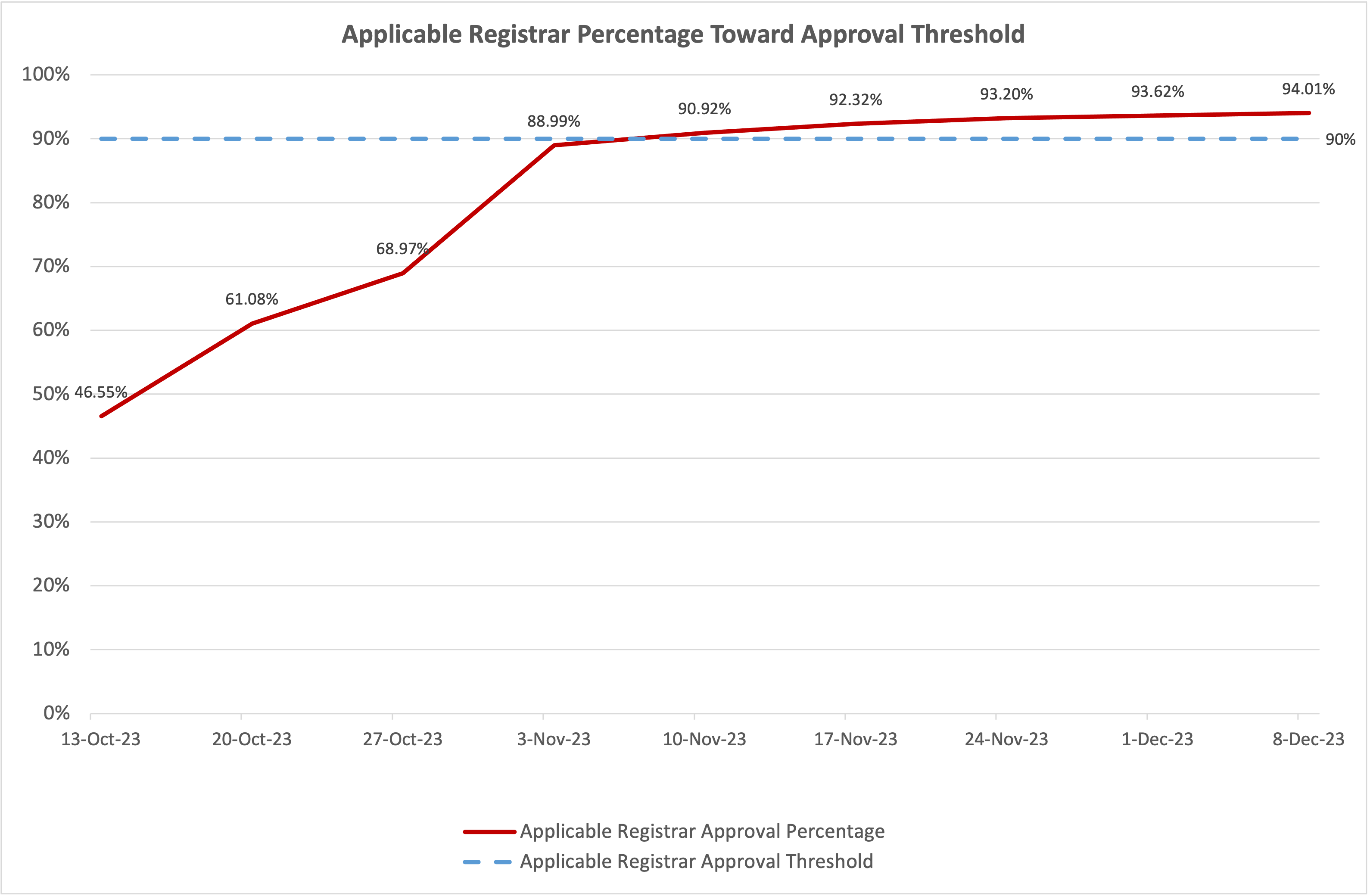2024 Global Amendments to the 2013 Registrar Accreditation Agreement (RAA) and Base gTLD Registry Agreement (Base RA)
| News | Relevant Resources | Webinar Recordings | Background |
| Voting Process and Procedures | Voting Calculations | Voting Progress | News Archive |
News
5 February 2024 – ICANN issued notice to registrars and registry operators noting the global amendments will be effective on 5 April 2024. ICANN also issued an Advisory that provides guidance on the interpretation of and compliance with the new requirements.
21 January 2024 – The ICANN Board approved the global amendments at a meeting held on 21 January 2024, as outlined in the Approved Board Resolution.
Relevant Resources
2013 Registrar Accreditation Agreement (RAA) – the global amendment to the RAA is effective 5 April 2024.
- 2013 Registrar Accreditation Agreement
- REDLINE of the 2013 Registrar Accreditation Agreement
- Global Amendment to the 2013 Registrar Accreditation Agreement
Base Generic Top-Level Domain (gTLD) Registry Agreement (Base RA) – the global amendment to the Base RA is effective 5 April 2024.
- Base gTLD Registry Agreement
- REDLINE of the Base gTLD Registry Agreement
- Global Amendment to the Base gTLD Registry Agreement
Webinar Recordings
On 21 September 2023, ICANN org held a webinar to review the proposed amendments to the RAA and Base RA, provide an overview of the voting processes and procedures, and took questions to ensure each registrar and registry operator had the information needed to participate in the vote. The webinar included real-time translation in Arabic, Chinese, French, Portuguese, Russian, and Spanish.
The webinar audio recordings are listed below by language:
| English | Arabic | Chinese | French |
| Portuguese | Russian | Spanish |
Background
In November 2022, the Registrar Stakeholder Group (RrSG) and Registries Stakeholder Group (RySG), collectively the Contracted Parties House (CPH), proposed to the ICANN organization (org) the idea of collaborating to enhance the existing contracts by creating clear obligations to stop or otherwise disrupt DNS Abuse. In their proposal, they suggested, and ICANN agreed, to certain guideposts for the amendments:
- The focus of the new provisions will be on DNS Abuse, as defined in the amendments;
- The amendments will neither include matters pertaining to website content abuses nor access to registration data;
- Any new provisions should appropriately reflect the roles and responsibilities of registrars and registries in each agreement, and will not seek to impose pass-through requirements on either group.
In January 2023, ICANN org responded to letters from the RrSG and RySG to formally initiate the process to amend the 2013 Registrar Accreditation Agreement (RAA) and the base gTLD Registry Agreement (Base RA) to strengthen the existing abuse mitigation obligations. The proposed amendments will enable ICANN Contractual Compliance to take enforcement actions against those registrars or registry operators who fail to take prompt and appropriate action reasonably necessary to stop or otherwise disrupt well-evidenced DNS Abuse.
This is an important building block in a longer journey that could include policy discussions open to the full ICANN community, and potentially future negotiations between the CPH and ICANN org. Further policy development could also be pursued in the Generic Names Supporting Organization (GNSO) to broaden the examination of what additional obligations should exist and define in more detail what is expected of registrars and registry operators in a community-wide process.
The resulting proposed amendments incorporate:
- Requirements to ensure abuse contacts are readily accessible on the contracted party's (CP's) webpage and to provide the reporter with confirmation upon receipt of abuse reports
- The ability for registrars and registry operators to use webforms instead of email as an abuse reporting mechanism
- A definition of DNS Abuse for purposes of the RAA and Base RA
- A specific requirement to promptly take appropriate mitigation actions against domains for which the contracted party has actionable evidence demonstrating that the domains are being used for DNS Abuse
- Recognition that CPs should exercise reasonable discretion in selecting and implementing appropriate mitigation actions depending on the circumstances of each case
- Recognition of the different roles of registrars and registry operators
- A target outcome of stopping or otherwise disrupting the use of gTLD domain names for DNS Abuse
In addition, the proposed amendment to the Base RA amends Specification 11, Section 3(b) to replace the term "security threats" with "DNS Abuse" which clarifies that registry operators must periodically conduct a technical analysis to assess whether domains in the top-level domain (TLD) are being used to perpetrate DNS Abuse and maintain statistical reports on identified DNS Abuse instances. A positive benefit of replacing "security threats" with "DNS Abuse" is that it expands the requirement for registry operators to include spam when it is used as a delivery mechanism for other forms of DNS Abuse. Additionally, this variation of spam will be added as something to include in their periodic analyses and reports.
The amendments are intended to result in prompt and reasonable mitigation actions that minimize the scope and intensity of the harm and victimization caused by DNS Abuse while limiting collateral damage caused by CPs' actions in response to the DNS Abuse. The proposed amendments contemplate that the best-equipped persons or entities conduct a thorough review of the matter, and take the appropriate, proportionate mitigation actions depending on the circumstances. The proposed amendments do not specify the mitigation actions or their timing as such approach may not guarantee the desired outcome in all instances. The negotiation teams discussed a prescriptive approach, but, ultimately, decided such an approach may unintentionally result in undesirable, disproportionate outcomes where DNS Abuse involves compromised domain names or delayed responses in situations where swift action is required. The appropriateness and promptness of the actions will depend on the specific circumstances of each case.
ICANN org also developed a draft ICANN Advisory that will be issued when the proposed amendments are approved and then posted on the Contracted Party Advisories webpage. The draft Advisory further explains the new requirements, provides guidance, and sets out expectations for action by CPs to establish compliance. The draft Advisory also elaborates upon terms like "mitigation actions," "appropriate," "stop" (contributing to stop), and "disrupt" (contributing to disrupt). Additionally, the draft Advisory contains examples of DNS Abuse, actionable evidence, and corresponding appropriate and prompt mitigation actions, considering the circumstances of each case.
The proposed changes to the RAA and Base RA were published for Public Comment on 29 May 2023. On 31 August 2023, ICANN org published the Public Comment Summary Report.
Voting Process and Procedures
On 25 September 2023, ICANN org sent a legal notice to registrar primary contacts and corporate contacts, and registry operator primary contacts and legal (notice) contacts informing registrars and registries that the voting period will open at 17:00 UTC on 9 October 2023.
On Monday, 9 October 2023, at 17:00 UTC the registrar and registry primary contact listed in the Naming Services portal (NSp) received an email communication from eBallot, a secure, third-party online voting platform operated by Votenet. The email was sent from noreply@eballot.com.
The email invitation contained a direct link to an online ballot which permits the primary contact to vote. The online ballot may be accessed from any smartphone or device with full-browser capabilities.
- For Registry Operators: If the registry primary contact's email address is associated with multiple gTLDs within the same registry operator account, the vote will apply to each gTLD that is associated with the registry primary contact's same email address. The registry primary contact will receive one email invitation per registry operator account, unless unique registry primary contact email addresses are associated with gTLDs under the registry operator account. In such instances, separate invitations will be sent to each unique registry primary contact email address associated with the registry operator account.
- For Registrars: If the registrar's primary contact email address is associated with more than one registrar (i.e., the registrar is part of a registrar group), the vote will apply to all associated registrars within that group.
Voting Options: Voters will have two options on how to vote:
- "Yes" – voting "yes" means that you approve the proposed global amendment.
- "No" – voting "no" means that you do not approve the proposed global amendment.
Abstaining or otherwise failing to vote is the same as voting "No."
Voting Preparation and What to Expect
What should you do to prepare for the voting period and what to expect after the voting has concluded?
- Review your primary contact information: Please review and ensure that your primary contact information in the Naming Services portal (NSp) is current and is the appropriate individual with the authority to cast a vote on behalf of the CP.
- The voting period opened on 9 October 2023 at 17:00 UTC and will remain open for sixty (60) days.
- After the voting period closes: The vote will be tabulated and then verified by Votenet, an independent third-party voting administrator. The proposed global amendment to the Base RA and RAA, respectively, the Base RA Global Amendment and RAA Global Amendment, will then be shared with the ICANN Board of Directors for their consideration.
- If approved: The Base RA and RAA Global Amendments shall be effective and deemed Approved Amendments to the Base RA and RAA, following a 60-day notice from ICANN. If the Global Amendments are not approved, they will go back to the negotiating teams to discuss next steps.
Vote Calculations
Registry Operator Approval
As defined in Section 7.6(j)(ii) of the Base RA, Registry Operator Approval requires meeting the following two thresholds:
- A "yes" vote by registry operators whose payments from the prior year account for two-thirds (⅔) of the total fees paid to ICANN; and
- A "yes" vote by the majority (greater than 50%) of registry operators. Note that each registry operator has one (1) vote per TLD registry agreement.
Registrar Approval
As more fully set forth in Section 1.20.1 of the RAA, Registrar Approval requires meeting the following threshold:
- A "yes" vote from registrars who make up 90% of the total registered domains under management (TDUM). Note that per Section 1.20.1 of the RAA the TDUM will be adjusted to more evenly distribute voting weight among registrars. The final TDUM adjustment will be based on the most recent Per-Registrar Transactions Report available prior to the conclusion of the voting period.
Voting Progress
Below are graphic representations of final vote towards the two thresholds required to achieve Registry Operator Approval and the threshold required to achieve Registrar Approval.
Registry Operators Vote
Registry Operators Fee Threshold Chart (below): this graph represents the final vote towards the affirmative approval of Applicable Registry Operators whose payments to ICANN accounted for two-thirds of the total amount of fees paid, pursuant to the Registry Agreement, the immediately previous calendar year.
*As of 8 December 2023
Applicable Registry Operators Majority Threshold Chart (below): this graph represents the final vote towards the affirmative approval of a majority of Applicable Registry Operators, with each Applicable Registry Operator having one vote per TLD registry agreement.
*As of 8 December 2023
Percentage Toward Approval Thresholds Chart: The below graph represents movement of the affirmative vote percentage over time towards the fee and majority thresholds required to approve the Base RA Global Amendment. Data points indicate dates at which ICANN gathered vote progress data from the third-party voting software.
*As of 8 December 2023
Registry Operator Voting Status: The excel file linked below shows a list of Applicable Registry Operators and whether an Applicable Registry Operator voted. The file includes the following data: (1) TLD; (2) Registry Operator Name; and (3) voting status where "X" indicates that a vote has been submitted.
- Applicable Registry Operator Voting Status (as of 8 December 2023)
Registrars Vote
Registrar Approval Threshold Chart: The below graph represents the final vote towards the affirmative approval of Applicable Registrars accounting for 90% of the total registered domain names under management (TDUM) by Applicable Registrars, calculated pursuant to Section 1.20.1 of the RAA.
*As of 8 December 2023
Percentage toward Approval Threshold Chart: The below graph represents movement of the affirmative vote percentage over time towards the threshold required to approve the RAA Global Amendment. Data points indicate dates at which ICANN gathered vote progress data from the third-party voting software.
*As of 8 December 2023
Registrar Voting Status: The excel file linked below shows a list of Applicable Registrars and whether an Applicable Registrar has voted. The file includes the following data: (1) Registrar IANA ID; (2) Registrar Name; and (3) voting status where "X" indicates that a vote has been submitted.
- Applicable Registrar Voting Status (as of 8 December 2023)
Registrar TDUM Report: The excel file linked below shows a list of Applicable Registrars and the TDUM count by Registrar from the most recently available Per-Registrar Transactions Report prior to the voting period closure, which in this instance is the report from October 2023.
The file includes the following data:
- Tab "Registrar TDUM Count": (1) Registrar IANA ID; (2) Registrar Name; and (3) Total Registered Domain Names Under Management (TDUMs) by Registrar.
- Tab "Top 5 Families TDUM Count": Top Five Registrar families (anonymized) and their respective TDUMs.
Transparency Notice: ICANN org voting administrator, Votenet, an independent third-party voting administrator will have access to voter data. During the 60-day voting period, ICANN org will publish data relating to the progress of the vote including whether a registry operator or registrar has voted, but ICANN org will not publish data regarding how individual registry operators or registrars vote except to the extent required by law, the ICANN Documentary Information Disclosure Policy, or other applicable policy.
*Note this webpage summarizes provisions in the RAA and Base RA to serve as a helpful resource. For the avoidance of doubt, no statement contained herein shall be deemed to modify or supplement in any way the provisions of the RAA and Base RA. All capitalized terms and referenced sections used throughout this webpage have the meaning described to them in the RAA and Base RA.
Archived Resources
-
2013 Registrar Accreditation Agreement (RAA)
-
Base Generic Top-Level Domain (gTLD) Registry Agreement (Base RA)
- Draft ICANN Advisory
- Global Amendment Voting: Frequently Asked Questions (FAQ)
News Archive
22 December 2023 – the final voting results are in. An email with the certified results has been sent to registrars and registry operators. Further details on the final results are also available below in the voting progress section of this webpage.
13 December 2023 – ICANN's Contracted Parties Approve New Obligations to Mitigate DNS Abuse blog written by Russ Weinstein, Vice President, Global Domains Division, Accounts and Services.
8 December 2023 – the voting period has closed and voting approval thresholds were met. See further details and preliminary results in the voting progress section of this webpage.
7 November 2023 – all approval thresholds have been met! See further details in the voting progress section of this webpage. Registrars and registries may continue to vote until 8 December 2023 23:59 UTC.
19 October 2023 – voting progress information is now available in the voting progress section of this webpage.
9 October 2023 – the voting period opened at 17:00 UTC. Registrars and registries may vote until 8 December 2023 23:59 UTC.
5 October 2023 – ICANN Contracted Parties Set to Vote on Proposed DNS Abuse Amendments blog written by Russ Weinstein, Vice President, Global Domains Division, Accounts and Services.
27 September 2023 – ICANN's "Day of DNS Abuse Discussions" Draws More Than 125 Participants blog written by Russ Weinstein, Vice President, Global Domains Division, Accounts and Services.
25 September 2023 – registry and registrar primary contacts, registry legal (notice) contact, and registrar corporate contact received a voting notice email informing registries and registrars that the voting period will open at 17:00 UTC on 9 October 2023.
21 September 2023 – the ICANN organization (org) hosted a webinar to review the proposed amendments and provide an overview of voting process and procedures. See the "Webinar" section below for further details.
4 September 2023 – "A Day of DNS Abuse Discussions" covered the proposed contract amendments for registrars and registry operators and what they mean for contracted parties. There were also discussions and capacity development sessions related to DNS abuse mitigation. Please visit the ICANN DNS Symposium (IDS) webpage for the recordings and presentations: https://www.icann.org/ids.
16 August 2023 – ICANN to Hold Meeting in Vietnam on DNS Abuse blog written by Russ Weinstein, Vice President, Global Domains Division, Accounts and Services.
13 June 2023 – DNS Abuse Negotiation: CPH Outreach Session. ICANN org and the CPH NT held a joint session to explain the amendments and take questions during ICANN77.
30 May 2023 – DNS Abuse Contract Amendments Update Session during Prep Week at ICANN77. ICANN org and the CPH NT held a joint session to explain the amendments and take questions.
30 May 2023 – ICANN and Contract Negotiations Update: Improved DNS Abuse Requirements blog written by Sally Costerton, Interim President and CEO.
18 January 2023 – ICANN and Contracted Parties Negotiate About Improved DNS Abuse Requirements blog written by Sally Costerton, Interim President and CEO.

